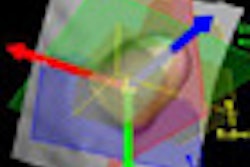ATLANTA - The diagnostic accuracy of coronary CT angiography (CTA) appears to be lower in patients with calcium scores higher than 600, researchers reported this week at the American College of Cardiology (ACC) meeting.
However, the researchers also found that inclusion of patients with severe coronary calcification does not alter the overall diagnostic accuracy of coronary CTA in detecting obstructive coronary artery disease in most patients.
CT's diagnostic accuracy was lower in patients with a calcium score of 600 or greater, and negative predictive value was poor in this subgroup, said Dr. Armin Zadeh, the associate director of cardiac CT and an assistant professor of medicine at Johns Hopkins University in Baltimore.
"The performance of current-generation MDCT in patients with severe coronary calcification is poor, compared to patients without severe disease," Zadeh said. "If the purpose is to exclude significant coronary artery disease and a patient has a high calcium score of 600 or greater, MDCT is not useful."
According to the researcher, there is very little good information on MDCT's diagnostic power for detecting obstructive coronary artery disease in patients with severe coronary calcification.
"In most studies, these patients are excluded or underrepresented," Zadeh said.
The new analysis involved 371 patients with suspected coronary artery disease who underwent calcium scoring and 64-slice CT in addition to conventional coronary angiography at nine centers.
All MDCT scans were acquired using a 64-row scanner with a slice thickness of 0.5 mm (Aquilion 64, Toshiba America Medical Systems, Tustin, CA).
Retrospective ECG gating was used for the coronary CTA exams. Intravenous iopamidol (Isovue 370, Bracco Diagnostics, Princeton, NJ) was applied via power injector. Beta-blockers were given if the heart rate was greater than 70 beats per minute.
For each patient, 19 coronary segments of 1.5 mm or more in diameter were visually graded by MDCT according to an ordinal scale. Then, segments with at least one visible stenosis of 30% or more were manually quantified with the use of commercially available software.
Conventional coronary angiography was performed within 30 days after MDCT angiography using standard techniques made uniform across all centers for quantitative coronary angiography. Intracoronary nitroglycerin (150 to 200 µg) was administered before the scans, and angiograms in DICOM format were transferred to the angiographic core laboratory.
The area under the receiver-operating-characteristic curve was used to evaluate diagnostic power relative to that of conventional angiography for detecting stenoses of 50% or greater. Of the total number of patients, 80 had calcium scores of 600 or greater.
Results showed the patient-based diagnostic accuracy of quantitative MDCT for detecting stenoses of 50% or greater according to conventional coronary angiography revealed an area under the curve of 0.93 for all patients and for patients with calcium scores less than 600.
For patients with higher calcium scores, the area under the curve was 0.80.
Sensitivity increased in the subgroup with calcium scores of 600 or greater: 94% versus 85%. However, specificity dropped, from 90% to 44%, largely due to very high disease prevalence, Zadeh reported.
For the entire cohort, the sensitivity was 88% and the specificity was 87%.
"In clinical practice, many dance around patients with high calcium scores. Some don't perform MDCT in these patients, and some do," Zadeh said. "Also, the threshold for high calcium scores is pretty arbitrary. A better method of evaluation may be needed."
By Charlene Laino
AuntMinnie.com contributing writer
March 18, 2010
Related Reading
Women sent to cath lab twice as often as men, March 15, 2010
Calcium findings on abdominal CT linked to heart attack risk, March 15, 2010
Analysis favors coronary CTA over stress MPS for chest pain, January 15, 2010
Patients with peripheral arterial disease may need cardiac imaging, December 30, 2009
Echocardiography test beats SPECT for predicting problems after MI, December 7, 2009
Copyright © 2010 AuntMinnie.com




















